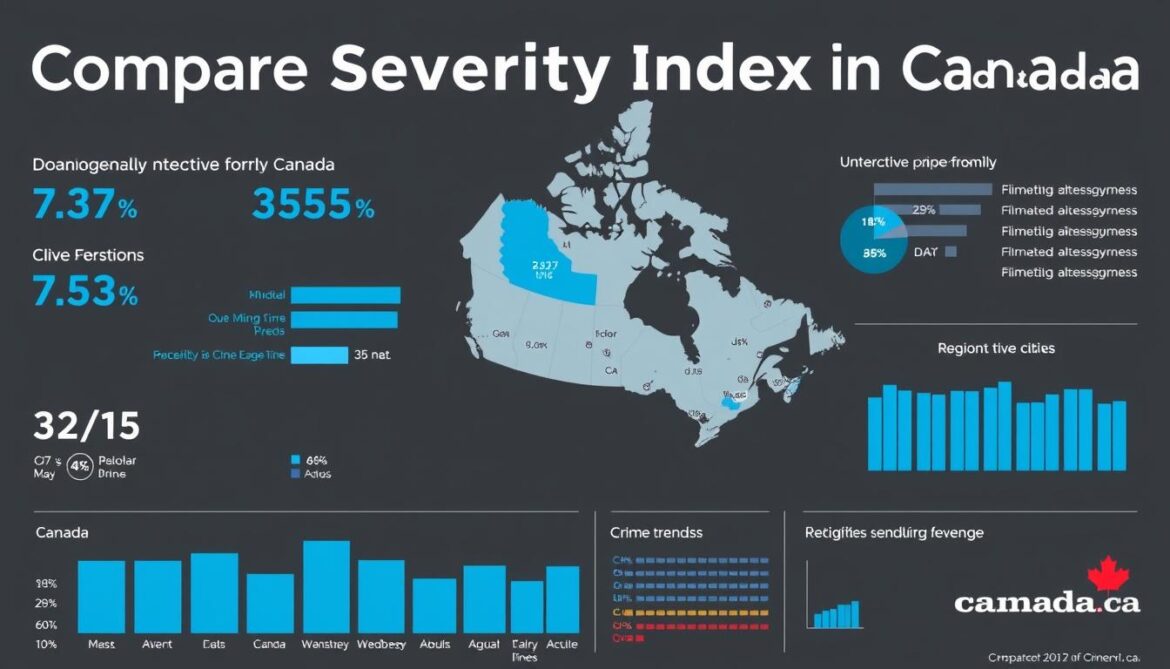Canada’s crime landscape is diverse, with some cities experiencing significantly higher crime severity than others. For instance, North Battleford in Saskatchewan has a crime rate of 598.5, starkly contrasting with cities like Oakville (26.1) and Quebec City (22.2). This disparity highlights the importance of understanding the Crime Severity Index (CSI), a critical metric used by Statistics Canada to measure criminal activity.
The CSI varies widely across Canadian metropolitan areas, with some showing increases in crime while others demonstrate decreases. This comprehensive guide will delve into the crime statistics across major Canadian cities, providing insights into the factors contributing to these trends and the methodology behind crime data collection.
Understanding Crime Rates in Canada
Understanding crime rates in Canada requires a nuanced approach that goes beyond simple crime counts. To accurately assess the safety of Canadian cities, it’s crucial to delve into the metrics and methodologies used to measure crime.
The Crime Severity Index (CSI)
The Crime Severity Index (CSI) is a sophisticated measurement tool developed by Statistics Canada. It assigns different weights to offenses based on their severity, providing a more nuanced view than simple crime counts. The CSI is calculated by weighting all crimes based on their seriousness, with more serious crimes given higher weights. This approach allows for a more accurate comparison of crime rates across different regions.
The CSI is a significant improvement over raw crime numbers, as it accounts for both the volume and seriousness of crimes. For instance, violent crimes are given more statistical weight than less serious infractions. This ensures that the CSI reflects the true impact of crime on communities.

How Statistics Canada Measures Crime
Statistics Canada collects crime data through the Uniform Crime Reporting (UCR) Survey, a standardized system that requires police services across the country to report incidents using consistent definitions and methodologies. This ensures that crime data is comparable across different regions.
The UCR Survey collects data on various types of crimes, including violent and non-violent offenses. The data is then used to calculate the CSI, providing a comprehensive picture of crime severity in Canada.
| Crime Type | Weightage | Description |
|---|---|---|
| Violent Crimes | High | Crimes that cause harm or threat to individuals, such as assault or robbery. |
| Property Crimes | Medium | Crimes that involve theft or damage to property, such as burglary or vandalism. |
| Other Crimes | Low | Crimes that do not involve direct harm or damage, such as disorderly conduct. |
As emphasized by the importance of understanding crime measurement,
“The way crime is measured can significantly impact our understanding of its prevalence and severity.”
This highlights the need for a nuanced approach to crime data analysis.
Crime Rate Comparison by City: Major Metropolitan Areas

Canada’s major cities exhibit diverse crime patterns, warranting a closer look at their crime rates. The Crime Severity Index (CSI) is a crucial metric for understanding these patterns, as it provides a comprehensive measure of crime rates.
Toronto vs. Vancouver vs. Montreal
Toronto, Vancouver, and Montreal are Canada’s largest metropolitan areas, each with unique crime profiles. Toronto has a CSI of 69.2, representing an 11.3% increase. Vancouver’s CSI stands at 97.0, with a 5.6% increase, while Montreal’s CSI is 80.0, with a modest 0.9% increase.
Notably, Toronto’s significant increase in CSI is a concern, while Vancouver’s higher CSI despite its smaller population compared to Toronto highlights the complexity of crime dynamics. Montreal’s stability in CSI suggests effective crime management strategies or different socioeconomic factors at play.
Key Statistics
- Toronto: CSI – 69.2 (+11.3%)
- Vancouver: CSI – 97.0 (+5.6%)
- Montreal: CSI – 80.0 (+0.9%)
Calgary vs. Edmonton vs. Ottawa
Calgary, Edmonton, and Ottawa present another interesting comparison. Calgary’s CSI is 72.5, with a notable decrease of 9.6%. Edmonton has a CSI of 113.3, with a slight increase of 0.6%. Ottawa’s CSI stands at 55.8, with a 3.1% increase.
The significant difference between Calgary and Edmonton’s CSI, despite their geographical proximity, underscores the impact of local policies and urban planning on crime rates. Ottawa’s low CSI reflects its status as the national capital, potentially benefiting from a higher security presence and different demographic composition.
Key Statistics
- Calgary: CSI – 72.5 (-9.6%)
- Edmonton: CSI – 113.3 (+0.6%)
- Ottawa: CSI – 55.8 (+3.1%)
Top 10 Canadian Cities with the Highest Crime Rates
Some Canadian cities are grappling with alarmingly high crime rates, a concern that necessitates a closer look at the factors contributing to these elevated levels of criminal activity.
North Battleford, Saskatchewan
North Battleford consistently ranks as one of Canada’s most dangerous cities, with a Crime Severity Index (CSI) of 598.5, representing a 6.6% increase. This alarming rate is nearly six times the national average, highlighting the need for targeted interventions.
Thompson, Manitoba
Thompson, Manitoba, is another city struggling with high crime rates. Factors such as its resource-based economy, geographic isolation, and socioeconomic challenges contribute to its elevated crime levels, despite various attempts at intervention.
Prince Rupert, British Columbia
Prince Rupert, a northern community in British Columbia, demonstrates concerning crime patterns. Both violent and property crimes significantly exceed national averages, a trend that persists despite its relatively small population.
Williams Lake, British Columbia
Williams Lake, another British Columbia city, faces similar challenges with high crime rates. The community’s crime issues are multifaceted, involving both violent and property crimes that surpass national norms.
Red Deer, Alberta
Red Deer, Alberta, shows a CSI of 146.9, although it has seen a 10.6% decrease in crime rates. This decrease suggests that targeted interventions can be effective in addressing safety challenges in high-crime communities.
These cities often share common characteristics, including geographic isolation, economic volatility, and limited social services, which can exacerbate crime levels. For more detailed information on Canadian cities with high crime rates, visit Canadian Cities with Highest Crime Rates.
| City | CSI | Change |
|---|---|---|
| North Battleford | 598.5 | +6.6% |
| Thompson | High | – |
| Prince Rupert | High | – |
| Williams Lake | High | – |
| Red Deer | 146.9 | -10.6% |

Understanding the complexities of crime in these cities is crucial for developing effective strategies to mitigate these issues. By examining the factors that contribute to high crime rates, communities and authorities can work together to create safer environments.
Top 10 Safest Cities in Canada
Canada is home to many safe cities, with some standing out for their exceptionally low crime rates. These cities are characterized by their low Crime Severity Index (CSI) scores, which indicate a strong emphasis on public safety and community well-being.
Quebec City, Quebec
Quebec City stands out as one of Canada’s safest urban centers, boasting a CSI of 22.2, which translates to a safety index of 77.8. This low crime rate can be attributed to effective community policing, strong social cohesion, and municipal governance that prioritizes public safety.
Burlington, Ontario
Burlington, located in Ontario’s Golden Horseshoe region, maintains a consistently low crime rate with a CSI score of 29.7. The city’s affluent demographics, strong educational system, and community-focused policing strategies contribute to its safety.

Oakville, Ontario
Oakville, another city in the Golden Horseshoe region, has a CSI score of 26.1, reflecting its low crime rate. Oakville’s safety can be attributed to its strong educational attainment and effective community-police relationships.
Ottawa, Ontario
As the nation’s capital, Ottawa maintains an impressive safety record with a CSI of 31.3. Despite being a major metropolitan area, Ottawa demonstrates that larger cities can achieve low crime rates with proper planning and resources.
Halton Region, Ontario
The Halton Region, which includes Burlington, Oakville, Milton, and Halton Hills, has a collective CSI of 31.4, making it one of Canada’s safest regions. Although the region experienced a modest increase in crime rates (+0.7%), its overall safety record remains strong.
These safe cities share common characteristics, including higher median incomes, strong educational attainment, effective community-police relationships, and well-developed social services that address the root causes of crimes before they escalate. By understanding these factors, other cities can work towards achieving similar safety statistics.
Violent Crime Statistics Across Canadian Cities
Violent crime rates vary significantly across Canadian cities, reflecting broader socioeconomic trends. Understanding these statistics is crucial for identifying areas that require targeted interventions and resources to improve public safety.
Cities with the Highest Violent Crime Rates
Some Canadian cities struggle with alarmingly high rates of violent crime. For instance, North Battleford, Saskatchewan, has a violent Crime Severity Index (CSI) of 661.4, marking a 9.7% increase. Thompson, Manitoba, is another city grappling with high violent crime rates, underscoring the challenges faced by certain communities in maintaining public safety.
These cities often contend with complex social issues, including substance abuse and limited economic opportunities, which contribute to higher rates of violent offenses. Addressing these underlying factors is critical to reducing violent crime rates.
| City | Violent Crime CSI | Change |
|---|---|---|
| North Battleford | 661.4 | +9.7% |
| Thompson | High | N/A |
Cities with the Lowest Violent Crime Rates
In contrast, some Canadian cities boast low violent crime rates, exemplifying effective crime prevention strategies and strong community support. Halton Region, Ontario, has a violent crime CSI of 31.7, representing a 14.7% decrease. Quebec City, Quebec, while generally safe, experienced a 15.4% increase in violent crime, with a CSI of 90.5.
These variations highlight the importance of tailored approaches to crime prevention, as well as the need for ongoing vigilance even in cities with overall low crime rates.
| City | Violent Crime CSI | Change |
|---|---|---|
| Halton Region | 31.7 | -14.7% |
| Quebec City | 90.5 | +15.4% |
As Statistics Canada reports, police-reported violent crime statistics reveal significant regional variations, with northern and prairie communities generally experiencing higher rates than southern Ontario and Quebec. This disparity underscores the influence of socioeconomic factors and resource distribution on crime rates.

Non-Violent Crime Patterns in Canadian Cities
Canada’s cities exhibit diverse trends in non-violent crime, reflecting local socioeconomic conditions and policing strategies. Non-violent crime encompasses a range of offenses including property crime, theft, and fraud, which significantly impact the quality of life and economic security in urban areas.
Property Crime Hotspots
Some Canadian cities stand out as property crime hotspots. For instance, Duncan, BC, has an extremely high non-violent Crime Severity Index (CSI) of 571.7, representing a significant increase of 127.5% in recent measurements. Other cities like Kelowna (143.4) and Victoria (182.5) also experience substantially higher property crime rates compared to the national average. These trends suggest that certain regions require targeted interventions to address the underlying causes of property crime.

Trends in Non-Violent Offenses
Trends in non-violent offenses reveal evolving patterns in criminal activity. Cities like Toronto have seen a concerning 17.8% increase in non-violent crime, driven by rises in theft, fraud, and property crimes. Conversely, Edmonton has made progress with a modest decrease (-1.2%) in its non-violent CSI, indicating that targeted policing strategies and community initiatives can be effective. For more detailed information on crime rates across Canada, visit Canada Crime Rates.
| City | Non-Violent CSI | Change (%) |
|---|---|---|
| Vancouver | 95.4 | -0.6% |
| Toronto | 59.1 | +17.8% |
| Edmonton | 105.7 | -1.2% |
| Duncan | 571.7 | +127.5% |
Understanding the Canadian Criminal Code

The Canadian Criminal Code is a foundational document that outlines the legal framework for criminal offenses in Canada. Understanding the Canadian Criminal Code is essential for grasping how crime is measured and reported across the country. It categorizes offenses into various types, including violent crimes, property crimes, and other Criminal Code violations, which are used by Statistics Canada to calculate the Crime Severity Index (CSI) annually.
Major Categories of Criminal Offenses
The Criminal Code classifies crimes into several major categories. Violent crimes include homicide, assault, sexual assault, and robbery. Property crimes encompass theft, breaking and entering, and fraud. Other Criminal Code violations include weapons offenses, administration of justice violations, and disturbing the peace. These categories are crucial for understanding the nature and severity of crimes reported in Canada.
How Crimes Are Classified and Reported
Statistics Canada relies on the standardized classifications within the Criminal Code to ensure consistent reporting across jurisdictions. The classification system assigns different weights to offenses based on their maximum penalties under the Criminal Code and actual sentencing patterns. This weighted system directly influences how each crime impacts the overall Crime Severity Index (CSI) calculation. Understanding this classification system is vital for interpreting crime statistics accurately, as changes in the Criminal Code or reporting practices can significantly impact statistical trends.
Factors Influencing Crime Rates in Canadian Cities
Canadian cities experience varying crime rates due to a complex interplay of factors. Understanding these factors is crucial for developing effective crime prevention strategies.
Socioeconomic Factors
Socioeconomic factors play a significant role in determining crime rates across Canadian cities. Communities with higher unemployment rates, lower educational attainment, and greater income inequality tend to report higher Crime Severity Index scores. These factors are strongly correlated with crime rates, indicating that addressing socioeconomic challenges is essential for reducing crime.
Population Density and Urban Planning
Population density and urban planning also significantly influence crime patterns. Densely populated areas can benefit from increased natural surveillance and community cohesion, but may also struggle with anonymity and reduced social controls. Effective urban planning, including mixed-use development and public space design, can enhance community safety by promoting social integration and economic opportunity.
Law Enforcement Resources
The allocation of law enforcement resources varies significantly across Canadian municipalities, affecting response times, investigative capacity, and preventive policing capabilities. Cities with more officers per capita tend to have better crime prevention and response outcomes. A comparative analysis of law enforcement resources across different cities is presented in the table below.

| City | Crime Severity Index | Law Enforcement Officers per 100,000 |
|---|---|---|
| Toronto | 74.85 | 183.6 |
| Vancouver | 101.45 | 160.2 |
| Montreal | 63.45 | 204.1 |
Preventing Crime in Canadian Communities

Canadian communities are implementing various strategies to prevent crime and enhance public safety. Effective crime prevention is a multifaceted challenge that involves community-based programs, municipal safety initiatives, and personal safety practices.
Community-Based Prevention Programs
Successful community-based prevention programs across Canada demonstrate that proactive approaches focusing on root causes can significantly reduce crime rates. For instance, St. Catharines implemented targeted initiatives that contributed to a 2.3% decrease in their Crime Severity Index (CSI). These programs often involve collaboration between local organizations, law enforcement, and community members to address specific needs and vulnerabilities.
Some key elements of these programs include youth intervention, mentorship, and educational support, which have shown particular promise in reducing both current and future crime rates. By investing in after-school activities and community engagement, cities can foster a safer environment and reduce the likelihood of criminal activity.
Municipal Safety Initiatives
Municipal safety initiatives vary widely across provinces, reflecting the diverse needs and priorities of different regions. Some jurisdictions emphasize Crime Prevention Through Environmental Design (CPTED) principles, modifying physical environments to reduce opportunities for criminal activity. This approach can include improving street lighting, designing public spaces to enhance visibility, and implementing other environmental changes to deter crime.
Other municipalities focus on community policing strategies, which foster strong relationships between law enforcement and residents. By embedding officers within the neighborhoods they serve, cities can build trust and cooperation, leading to more effective crime prevention and reduced crime levels.
Personal Safety Tips
While community-based programs and municipal initiatives are crucial, personal safety practices remain important complementary measures. Being aware of one’s surroundings, securing property, and participating in community vigilance initiatives can all contribute to overall safety in both high and low-crime areas across Canadian cities.
Residents can take simple steps such as ensuring their homes are secure, being cautious in isolated areas, and reporting suspicious activity to the authorities. By combining these personal efforts with broader community initiatives, Canadians can work together to prevent crime and enhance public safety.
Conclusion: The State of Crime in Canada
Analyzing crime statistics across Canadian cities reveals a nuanced picture of safety and crime. Canada’s national Crime Severity Index has shown fluctuating patterns in recent years, with some regions experiencing significant increases while others demonstrate successful crime reduction strategies.
Regional variations remain pronounced, with prairie provinces and territories generally reporting higher CSI scores than Quebec and Ontario. This reflects persistent socioeconomic differences and varying approaches to crime prevention across provinces.
Metropolitan areas demonstrate distinct crime patterns compared to rural communities. Larger cities typically experience higher volumes but often lower severity of crimes per capita than smaller, isolated communities that top the CSI rankings.
According to Statistics Canada data, while violent crime remains a serious concern in specific communities, non-violent offenses like property crime and fraud constitute the majority of police-reported incidents across most Canadian jurisdictions.
The future of crime prevention in Canada likely depends on integrated approaches that combine effective policing, social services, community engagement, and economic development tailored to each community’s specific challenges and resources.
Understanding these crime patterns through detailed statistical analysis provides valuable insights for policymakers, law enforcement agencies, and community organizations working to create safer environments across Canadian cities and provinces.

